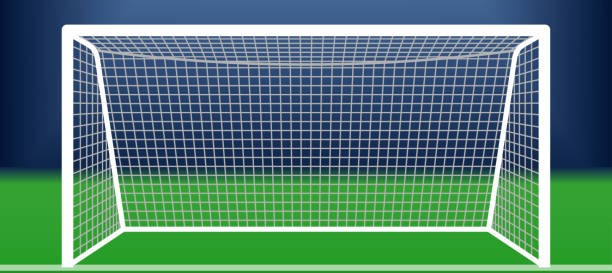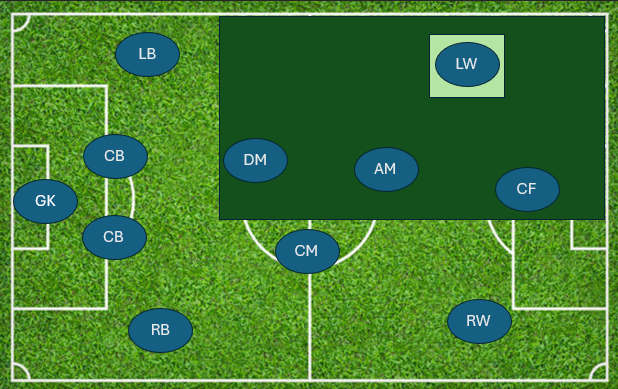













THE LEFT WINGER.

The left winger in football is an attacking player who operates primarily on the left flank of the field.
Their primary role is to provide width, create goal-scoring opportunities, and contribute to both the attacking and defensive phases
of the game. Left wingers need to be fast, skilled with the ball, and tactically aware to exploit the wide areas and stretch the
opponent's defense. Here’s a detailed breakdown of the left winger’s role:
Positioning:
- ▫ WIDE ON THE LEFT FLANK: The left winger is positioned on the left side of the pitch, typically along the touchline, providing width
to the team’s attack. They stay wide to stretch the opposition defense and create space in the center of the field.
- ▫ HIGH ATTACKING POSITION: In most formations, the left winger plays high up the pitch, often level with or slightly behind the
team’s forwards. Their role is to push into the attacking third and deliver crosses or cut inside for shots.
- ▫ TOUCHLINE OR INVERTED WINGER: Traditional wingers hug the touchline and deliver crosses, while inverted wingers (like left-footed players
on the right or right-footed players on the left) often cut inside toward the center to shoot or combine with teammates.
Primary Role: Attacking and Creating Chances
- ▫ PROVIDING WIDTH: Left wingers stretch the opposition defense by staying wide. This opens up space for the team’s central players
(forwards, attacking midfielders) to operate.
- ▫ CROSSING: One of the key duties of a traditional left winger is to deliver crosses into the penalty area for the forwards to score.
These crosses can come from wide areas or near the byline after beating a defender.
- ▫ CUTTING INSIDE: Many modern left wingers are right-footed, meaning they often cut inside from the left flank toward the center to take
shots or link up with central attacking players. This creates additional goal-scoring opportunities and can disrupt the opposition’s
defensive shape.
- ▫ DRIBBLING: Wingers are often excellent dribblers who can take on defenders one-on-one. Their ability to beat full-backs with speed
and skill is crucial for breaking down defensive lines.
Supporting the Forward Line:
- ▫ ASSISTING THE MAIN STRIKER: Left wingers frequently supply the main striker with crosses and passes. They play a vital role in feeding
goal-scoring opportunities to the forwards by delivering accurate passes into the box.
- ▫ SECONDARY GOAL SCORER: In many teams, the left winger is also expected to score goals themselves. When cutting inside, they can
create space for shots on goal, making them a secondary attacking threat.
- ▫ COMBINATION PLAY: Left wingers often link up with the left-back or central midfielders in quick passing combinations to advance
the ball into dangerous areas. This helps create overloads on the left side of the pitch, outnumbering the opponent.
Defensive Responsibilities:
- ▫ TRACKING BACK: Although primarily focused on attack, left wingers also have defensive duties. They must track back to help the
left-back when the team is under pressure, especially when the opposition’s right winger is attacking.
- ▫ PRESSING AND CLOSING DOWN: Modern left wingers are expected to press the opponent’s right-back or defensive players to win the ball
higher up the pitch. This defensive pressing is key to disrupting the opposition’s buildup play.
- ▫ MARKING AND COVERING: Wingers need to mark the opposition’s right-sided players when defending, particularly during set-pieces
or when the opponent is building play down their side.
Tactical Variations:
- ▫ TRADITIONAL WINGER (TOUCHLINE HUGGER): A traditional left winger stays wide, looking to beat defenders and deliver crosses from
the flank. This type of winger primarily focuses on stretching the defense and supplying balls into the box.
- ▫ INVERTED WINGER: An inverted winger plays on the opposite side of their strong foot (e.g., a right-footed player on the left wing).
This allows them to cut inside onto their stronger foot, creating shooting opportunities or linking up with the striker and
midfielders.
- ▫ WIDE FORWARD: In some formations (like 4-3-3 or 3-4-3), the left winger plays as more of a wide forward, staying higher up the
pitch and focusing heavily on goal-scoring, almost like a secondary striker.
Skills and Attributes:
- ▫ PACE: Speed is one of the most important qualities for a winger. Left wingers need to be quick to beat defenders, make runs
behind the opposition’s defense, and recover defensively when needed.
- ▫ DRIBBLING ABILITY: Good dribbling skills are essential, as wingers often face one-on-one situations with opposing full-backs.
They must be able to change direction quickly, perform feints, and use close control to get past defenders.
- ▫ CROSSING: Left wingers need to be able to deliver accurate crosses into the penalty area. This can include low, driven crosses
or lofted balls for the forwards to attack.
- ▫ SHOOTING: Many modern wingers are expected to be capable of scoring goals, especially when cutting inside onto their stronger foot.
Left wingers must be able to take shots from a variety of positions, inside and outside the box.
- ▫ TACTICAL AWARENESS: Understanding when to stay wide and when to cut inside is crucial. A winger needs to read the game well and
exploit defensive weaknesses, knowing when to make attacking runs or combine with teammates.
- ▫ STAMINA AND WORK RATE: Wingers are expected to cover a lot of ground during a match. They must sprint repeatedly, track back
defensively, and press high up the pitch, which requires excellent stamina and a strong work rate.
Formations and the Left Winger's Role:
- ▫ 4-3-3 FORMATION: In this setup, the left winger plays as one of the three forwards alongside the center forward and the right winger.
Their job is to provide width, deliver crosses, and support the central striker by cutting inside or staying wide to create chances.
- ▫ 4-4-2 FORMATION: In a more traditional 4-4-2, the left winger is positioned as part of the midfield line. Their role here involves
more defensive work, tracking back to assist the left-back, while still providing width and attacking threat down the left.
- ▫ 3-4-3 FORMATION: In a 3-4-3, the left winger can take on a more attacking role, often positioned as a wide forward. This system
allows the left winger to focus more on goal-scoring and attacking, with less defensive responsibility since the wing-back provides
additional cover.
Summary: The left winger is an essential attacking player who provides width, crosses, and goal-scoring opportunities. They stretch
the opposition's defense, create space for teammates, and are responsible for delivering dangerous balls into the box or cutting inside
to take shots. Defensively, left wingers help track back and press the opposition’s right-sided players. Modern left wingers must be
fast, technically skilled, and tactically versatile to succeed in today’s high-paced game.




























